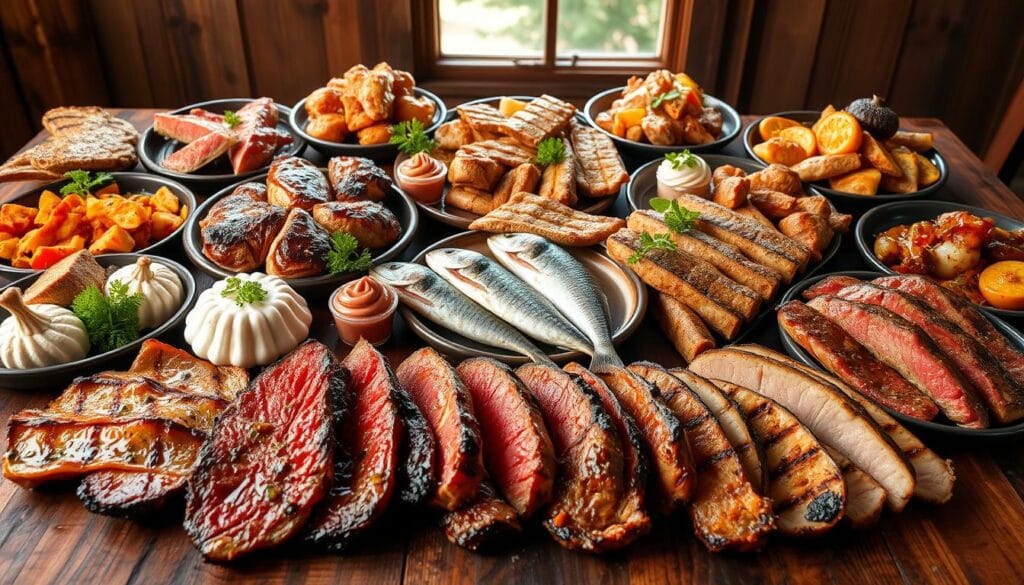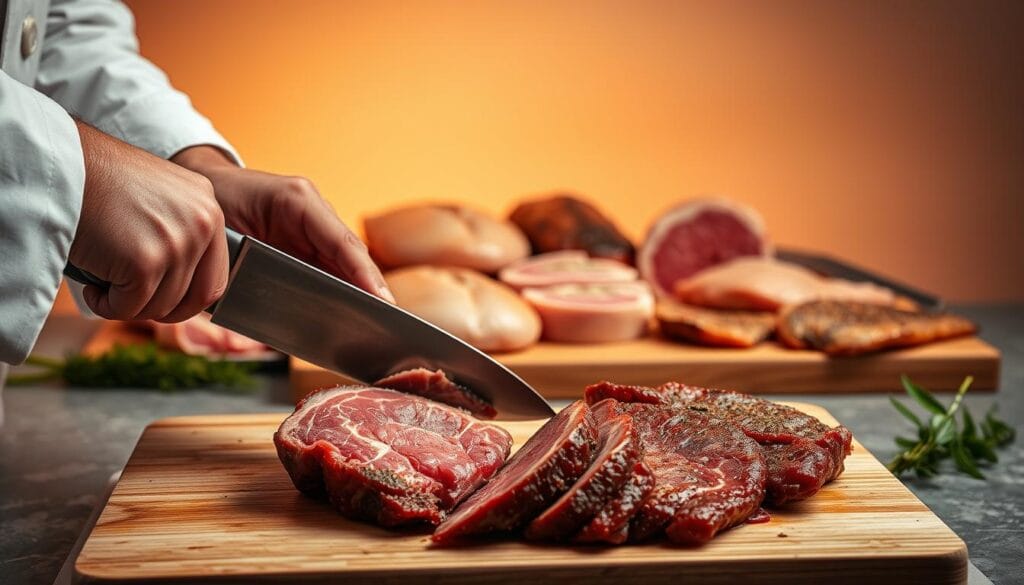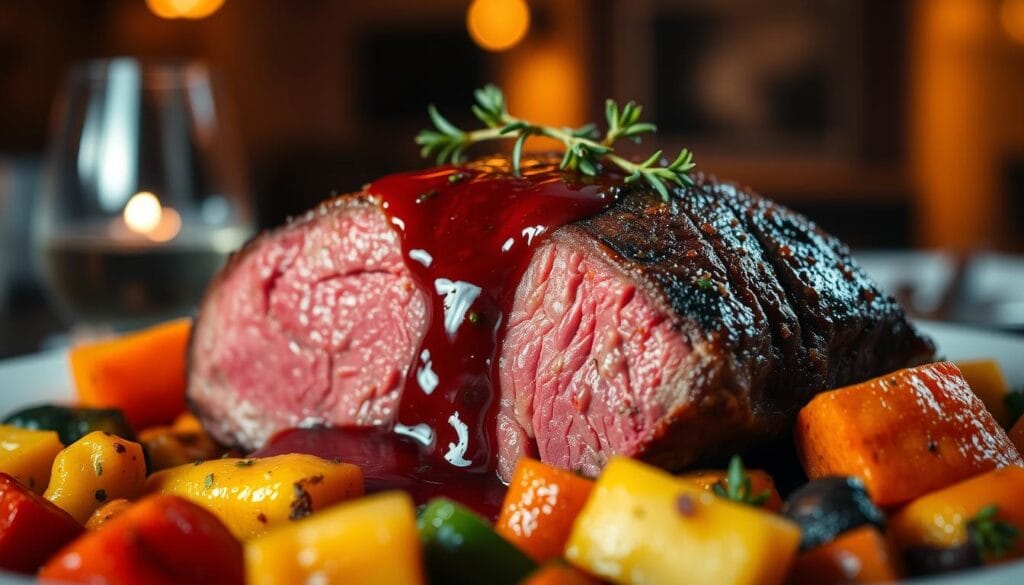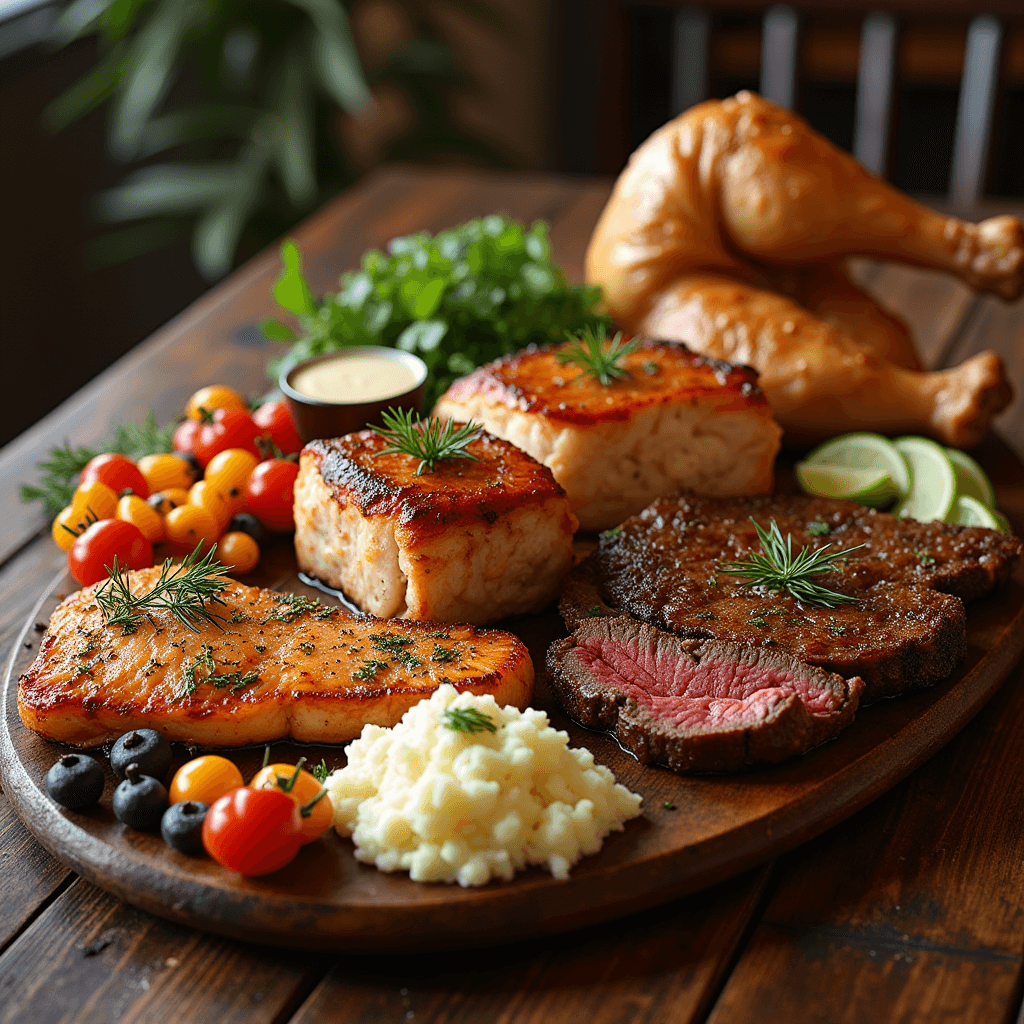10 different meat dishes: beef ,Chicken ,Desserts and Fish
Table of Contents
Every kitchen has its own story. Mine started with a perfectly seared steak. It changed how I saw meat dishes. Growing up, my grandmother made simple ingredients into amazing meals. She inspired me to try different meat recipes.

Start a tasty journey through meat dishes that will make you a better cook. You’ll learn about delicious beef and chicken recipes. This guide will show you how to make amazing meals at home.
Your cooking adventure will cover many flavors and techniques. We’ll look at both classic and new ways to cook meat. You’ll get ideas and confidence to try new things in your kitchen.
Key Takeaways
- Discover diverse meat dishes from around the world
- Learn essential cooking techniques for beef, chicken, and fish
- Understand flavor combinations and marination strategies
- Explore both traditional and modern meat preparation methods
- Gain insights into selecting and preparing high-quality meats
Understanding the Art of Preparing Meat Dishes

Mastering meat dishes takes skill, knowledge, and the right approach. Whether you’re cooking pork, lamb, or other meats, knowing basic cooking techniques is key. It can change how you cook.
Cooking meat is both an art and a science. Success comes from choosing quality ingredients, using the right tools, and applying the correct cooking methods.
Essential Kitchen Tools for Meat Preparation
- Sharp chef’s knife for precise cutting
- Digital meat thermometer
- Cutting boards (separate for raw and cooked meats)
- Heavy-duty roasting pan
- Cast iron skillet
Basic Cooking Methods for Different Meats
Each meat type needs a special approach to enhance its flavors. Grilling is great for beef and lamb, while braising is best for tougher cuts.
- Roasting: Ideal for large cuts of meat
- Sautéing: Great for thin slices
- Braising: Perfect for tough meat cuts
- Grilling: Adds smoky flavor to meat dishes
Temperature Guidelines for Perfect Results
Food safety and taste depend on the right internal temperature. Here’s a quick guide for meat doneness:
“Cooking meat to the correct temperature ensures both safety and maximum flavor.” – Professional Chef
To make restaurant-quality meat dishes at home, learn these basic techniques. With practice, patience, and precision, your cooking will improve.
Classic Beef Tenderloin with Red Wine Sauce

Take your beef recipes to the next level with this elegant dish. It turns a simple dinner into a fancy meal. Beef tenderloin is the top choice for barbecue lovers, known for its tender texture.
Choosing the right beef tenderloin is key. Look for meat that’s lean and has a deep red color. Quality preparation and cooking are crucial for a great dish.
- Choose prime-grade beef for maximum tenderness
- Allow meat to reach room temperature before cooking
- Season generously with kosher salt and fresh cracked pepper
- Use a reliable meat thermometer for perfect doneness
The red wine sauce makes this dish stand out. A robust red wine like Cabernet Sauvignon adds a rich flavor that goes well with the tender meat.
“Great cooking is about passion, technique, and understanding ingredients.” – Unknown Chef
Professional chefs say to sear the tenderloin at high heat to keep juices in. Then, finish it in the oven. This way, you get a golden-brown outside and a juicy inside.
Cooking Temperature Guide
| Doneness | Internal Temperature | Cooking Time |
|---|---|---|
| Rare | 125°F | 20-25 minutes |
| Medium Rare | 135°F | 25-30 minutes |
| Medium | 145°F | 30-35 minutes |
Learn to make this classic beef tenderloin recipe. You’ll turn simple meals into special occasions that celebrate the joy of cooking.
Mediterranean Grilled Chicken with Herbs

Explore the vibrant world of Mediterranean chicken meals. They turn simple cooking into a culinary journey. This recipe combines fresh herbs, bold flavors, and expert techniques for a dish that will wow everyone.
Selecting the Perfect Herbs and Marinades
Creating great chicken meals begins with the right herbs and marinades. For true Mediterranean taste, use these key ingredients:
- Fresh rosemary
- Thyme
- Oregano
- Garlic
- Olive oil
- Lemon juice
Grilling Techniques for Juicy Chicken
Learning grilling techniques keeps your chicken tender and tasty. Preheat your grill to medium-high heat. Follow these steps:
- Marinate chicken for 2-4 hours
- Pat chicken dry before grilling
- Use indirect heat method
- Check internal temperature reaches 165°F
Serving Suggestions and Pairings
Enhance your chicken with sides that match Mediterranean flavors. Try Greek salad, roasted veggies, or quinoa. For seafood fans, pair with grilled shrimp or tzatziki sauce.
Pro tip: Let grilled chicken rest for 5-10 minutes before serving. This helps keep juices in and flavors rich.
Pan-Seared Salmon with Lemon Butter
Take your seafood game up a notch with a pan-seared salmon dish. It turns a simple fish into a gourmet meal. Wild-caught Alaskan salmon is the top choice for its taste and health benefits.
To make perfect salmon, follow these steps:
- Choose fresh, high-quality salmon with firm, bright flesh
- Pat the salmon dry for a crispy exterior
- Use a heavy-bottomed skillet for even heat
- Cook skin-side down first for a crispy texture
For a top-notch lemon butter sauce, you’ll need:
| Ingredient | Quantity |
|---|---|
| Unsalted butter | 4 tablespoons |
| Fresh lemon juice | 2 tablespoons |
| Chopped parsley | 1 tablespoon |
Your charcuterie platters will shine with this salmon dish. Cook the salmon to 145°F for a moist, flaky texture. Pro tip: Let the salmon rest for 3-5 minutes after cooking to retain its juiciness.
“A perfectly cooked salmon is a culinary art that balances technique and simplicity.” – Professional Chef
Pair your salmon with roasted veggies or a light salad. This makes a balanced, nutritious meal that will wow your guests.
Savory Meat-Based Desserts Around the World
Get ready for a food adventure that changes how you see desserts. Meat dishes are now in sweet treats, exciting your taste buds and surprising you.
Meat-based desserts open a world of creativity in food. They mix savory and sweet in new ways, surprising everyone.
Traditional Meat Dessert Recipes
Across the globe, people have mixed meat with sweets for ages. Here are some amazing examples:
- Middle Eastern ma’amoul bi lahme – a pastry with spiced meat
- Filipino tocino del cielo – a mix of eggs and meat in a sweet treat
- Brazilian puddings with a meat twist
Modern Interpretations and Fusion Dishes
Today’s chefs are trying new things with meat in desserts. They turn old ingredients into new, exciting dishes.
Pairing Suggestions for Meat Desserts
When you serve these unique desserts, think about drinks and sides that match their flavors. A good red wine or craft cocktail can make the meaty sweetness even better.
“Culinary innovation begins where tradition ends.” – Chef Experimental
If you love trying new foods or cooking at home, meat-based desserts are a must-try. They show that the kitchen is a place for endless creativity.
BBQ Pork Ribs with Homemade Sauce
Want to wow your guests with the best pork dishes? BBQ pork ribs are a top choice. They mix tender meat with tangy flavors. To make them, you need to prepare well and use some special techniques.
Choosing the right ribs is key to great BBQ. Look for:
- Spare ribs with good meat coverage
- Baby back ribs for a leaner option
- St. Louis-style ribs for even cooking
Your homemade BBQ sauce can make these ribs unforgettable. The trick is to mix sweet, tangy, and spicy flavors. Start with a base of:
- Tomato sauce
- Brown sugar
- Apple cider vinegar
- Worcestershire sauce
Low-and-slow cooking makes tough meat tender and delicious. Cook your ribs at 225°F for 4-5 hours. Wrap them in foil to keep them moist. Then, glaze them with your sauce for a caramelized finish.
“Great BBQ is an art form that takes patience and passion.” – Professional Pitmaster
BBQ styles from different places add special touches to ribs. From Kansas City’s sweet sauce to Texas’s spicy rub, you can find your favorite flavor.
Seafood and Fish Combination Platters
Making stunning seafood platters needs skill and creativity. Your seafood platter can turn a simple meal into a memorable dining experience. Professional chefs know that picking the right seafood mix is key for great taste and looks.
When making seafood platters, keep these points in mind:
- Freshness of seafood
- Diverse texture combinations
- Complementary flavor profiles
- Seasonal availability
Veal can add a special touch to seafood platters, offering a unique contrast. Your platter might have different cooking methods to show off various textures and flavors.
| Seafood Type | Cooking Method | Recommended Pairing |
|---|---|---|
| Shrimp | Grilled | Lemon butter sauce |
| Scallops | Pan-seared | Herb-infused oil |
| Salmon | Baked | Dill cream sauce |
To make your seafood platter stand out, focus on presentation. Arrange items nicely, use garnishes carefully, and pick sauces that highlight each seafood’s special qualities.
Essential Tips for Perfecting Your Meat Dishes
Mastering meat dishes is more than just loving to cook. Whether it’s lamb or beef, knowing key techniques can make your cooking stand out. The right way to store, season, and prepare meat is key to making meals that taste like they came from a restaurant.
Professional chefs start preparing meat long before they cook it. Storing meat properly is key to keeping it safe and fresh. Always store raw meat in sealed containers on the bottom shelf of your fridge. This prevents cross-contamination. When cooking lamb or other meats, use clean cutting boards and wash your hands often to keep food safe.
Seasoning is an art that can take your meat dishes to the next level. Learn to mix salt, herbs, and spices to enhance the natural flavors of different meats. Marinating can make tougher meats tender and flavorful. Understanding how marinades work with different meats can lead to amazing tastes.
Avoiding common mistakes is crucial for culinary success. Keep an eye on cooking temperatures and use a meat thermometer for the right doneness. Letting your meat rest after cooking is also important. These steps can prevent dry, tough meat and help you serve dishes that impress everyone.
FAQ
What are the best cooking methods for different types of meat?
Each meat type needs a special cooking way. Beef is great with roasting, grilling, or braising. Chicken does well with roasting, grilling, or pan-searing. Fish is best cooked quickly, like pan-searing, baking, or poaching.
Pork loves slow cooking, grilling, and roasting. The trick is to pick the right method for the cut and texture you want.
How can I ensure my meat is cooked to the right temperature?
Always use a meat thermometer. For beef, aim for 145°F for medium-rare and 160°F for medium. Chicken needs to hit 165°F for safety.
Pork is safe at 145°F with a three-minute rest. Fish is done when it flakes easily and hits 145°F. Let meats rest after cooking to keep juices in.
What are some tips for marinating meat?
Good marinating starts with acidity like vinegar or citrus. Add oil to keep flavors in and prevent drying. Herbs and spices add depth.
Marinate in the fridge, not at room temperature. For most meats, 2-8 hours is best. Too long can make it mushy, especially with fish and chicken.
How do I choose the best cuts of meat for different dishes?
The right cut depends on how you cook it. Tender cuts like beef tenderloin are best for quick, high-heat cooking. Tougher cuts like beef brisket or pork shoulder need slow cooking.
Chicken breasts are good for grilling and sautéing. Chicken thighs are more forgiving and flavorful. For fish, choose fresh, firm-fleshed varieties for grilling, and more delicate fish for poaching or baking.
What are some common mistakes to avoid when cooking meat?
Don’t overcrowd the pan, which stops proper browning. Let meat come to room temperature before cooking. Skipping the resting period after cooking is a big mistake.
Use sharp knives for prep and pat meat dry before seasoning. Season well, sear with high heat, and let meats rest to keep juices in. Watch cooking times and temperatures to avoid overcooking or undercooking.
Can I prepare meat dishes in advance?
Yes, many meat dishes can be made ahead. Braised meats and stews get better with time. Marinades can be made ahead too.
Some roasts and slow-cooked dishes can be partially cooked and finished later. But, cook grilled or pan-seared meats just before serving for best texture and temperature. Always store cooked meats in the fridge and reheat carefully.
What are some healthy cooking methods for meat?
Choose low-fat methods like grilling, baking, poaching, and steaming. Remove visible fat before cooking. Use herbs and spices instead of heavy sauces.
Go for lean cuts of meat and trim excess fat. Consider portion control and balance meat with lots of veggies. Skinless chicken, fish, and lean beef cuts are great protein sources when cooked healthily.

